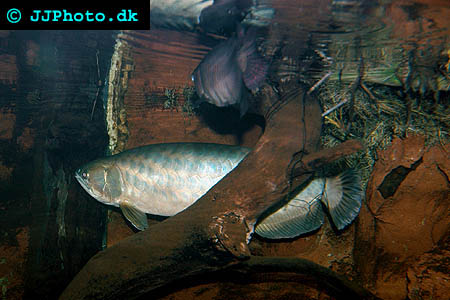Tag Archives: arowana
Stingray mass death in U.S. Zoo
Eleven of the 18 freshwater stingrays living at the U.S. National Zoo died over the holiday weekened, together with two arowanas. All dead fishes were residents of the zoo’s Amazonia exhibit; a 55,000-gallon (208,000 L) aquarium designed to replicate a flooded Amazon forest. Zoo officials are now suspecting low oxygen levels to be behind the sudden mass death.
Picture of Motoro Sting Ray, Ocellate river stingray – Potamotrygon motoro. Not one of the dead rays.
Copyright www.jjphoto.dk
As soon as the deaths were discovered 7 a.m Monday morning, zookeepers tested the water and found low levels of dissolved oxygen. They immediately started supplementing the aquarium with reservoir water and no more fish have died so far. In addition to stingrays and arrowanas, the Amazon aquarium is also home to discus, boulengerella fish, and a large school of guppies. By 10:15 a.m. Monday, the oxygen levels were back to normal but zookeepers continue to monitor the health of the surviving fish just in case.
Necropsies performed on the dead fish did not unveil any definite cause of death, which makes low oxygen levels even more likely, according to National Zoo officials. They do not believe human error caused the oxygen drop, since all protocols and checks were properly followed Sunday night.
Insufficient levels of dissolved oxygen in the water are one of the most common causes of fish mass death, in the wild as well as in captivity. Last year, 41 stingrays died at the Calgary Zoo in Canada due oxygen scarcity in the water.
Asian arowana bred in Bristol
First of, let me tell everyone how sorry I am that I have been posting a bit sporadic lately. Things have been crazy but hopefully they will improve even though it still might be a couple of weeks until they do. Until then you will unfortunately have to be content with the host I do manage to post. But now, without further ado, on to the Asian arowana
Asian Arowana – Scleropages formosus. Copyright www.jjphoto.dk
Bristol Zoo Gardens have bred the rare Asian Arowana (Scleropages formosus). The spawning resulted in 15 fry which are now estimated to be nine weeks old. The staff did not witness the spawning which is why they can only estimate the age of the fry for this mouth-breeding species. It is not the first time the Asian Arowanas have spawned in Bristol Zoo Gardens, but it is the first time the fry have survived.
Bristol Zoo Gardens has kept four Arowanas, also known as Dragon fish, for 13 years. They received the specimens from the UK custom services who had confiscated them after revealing an attempt to smuggle them into the country.
The zoo has recently taken steps to improve the Arowana exhibit by using reverse osmosis, and has also increased the temperature in the holding tanks. The assistant curator of the aquarium at Bristol Zoo Gardens, Jonny Rudd, believes that one of these actions might be the reason behind the successful breeding. This might very well be true but I also wish to mention the possibility that it might simply have to do with the parents getting more mature and learning from past failures, a well known phenomenon in mouth brooding fish and other fish that care for their young.
This is as far as I know the first time this species have been bred outside Asia.
The Asian Arowana is very rare in the wild and is on the brink of extinction in Thailand. It is red listed by Cites and can not be imported to many countries. This species is bred in farms in Asia where it is a popular exclusive aquarium fish, believed to bring luck due to its resemblance to a dragon. It is today available in a variety of different colorations and morphs. In Asia you can by farm bred fish with certifications stating that they are farm bred and not wild caught, and some countries allow you to import such specimens. You can read more about the Asian Arowana here.
Fisherman Catches ‘Lucky’ Horned Snakehead Fish in Malaysia
Saibi Ramli, a Malaysian fisherman, has caught a snakehead fish with a 2 cm (0.8 inch) horn on its head, Underwatertimes.com reports. Saibi Ramli caught the fish in a fish pond behind his home in Siburan, Kuching, using hook and bait. Ramli says he has never seen anything like it in his life and refuses to sell the catch since he is positive that the fish will bring him luck. “I have received many offers from wealthy people but I told them it’s not for sale”, Ramli explains.
You can read the full article and watch the picture of the horned creature at Underwatertimes.com. http://www.underwatertimes.com/news.php?article_id=45107920638 (source:http://www.brunei-online.com)
Asian Snakeheads, especially the Arowana Scleropages formosus, are viewed as bringer of luck by many Asians. Snakeheads are often referred to as “Dragon fish” in Asia, not chiefly because they somewhat resemble dragons but because they are seen as an incarnation of the mythological Asian dragon itself. In European fairytales the dragon is normally perceived as something evil that should be slaughtered, but this is certainly not the case in Asia. The Asian dragon is associated primarily with happiness and good fortune and keeping “Dragon Fish” in your aquarium is believed to attract luck to your home and ward of evil.
You can learn more about Asian Snakeheads here and about Scleropages formosus in particular here .

